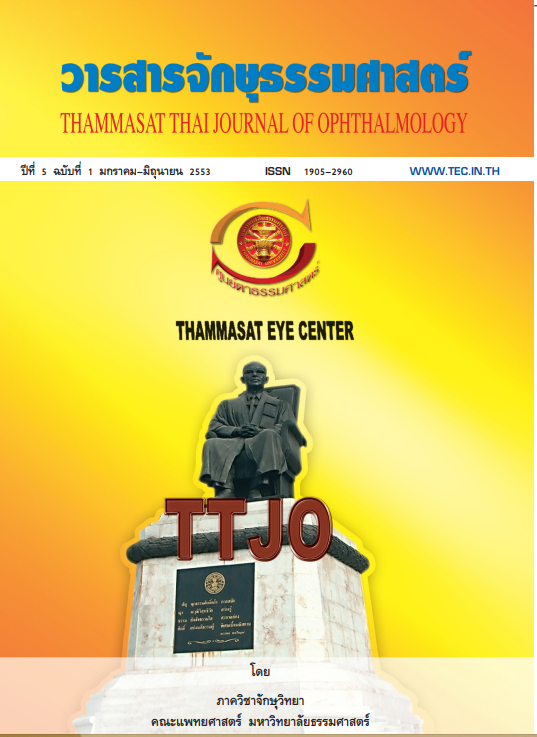Anti-Inflammation Efficacy of 0.1% Nepafenac and 0.1% Fluorometholone in Postoperative Uncomplicated Phacoemulsification and Iol Implantation
Main Article Content
Abstract
Purpose: To compare efficacy of inflammatory control in uncomplicated postoperative phacoemulsification with intraocular lens implantation between 0.1% Nepafenac (Nevanac®, Alcon) and 0.1% Fluorometholone acetate (Flarex®, Alcon)
Study design: Prospective randomized clinical trial
Method: Sixty-two eyes from 62 postoperative cataract surgery patients were randomized to either receive 0.1% Nepafenac (Nevanac®, Alcon) or 0.1% Fluorometholone acetate. Age, sex, diagnosis, and initial intraocular pressure (IOP) were recorded pre-operatively. Post-operative prescription 0.5% Moxifloxacin (Vigamox®, Alcon), preservative free tear were prescribed in both groups. Intraocular pressure, anterior chamber cell/flare, patientûs discomfort interview were recorded on 1-day, 1-week, 3-week, 6-week and 12-week post-operatively. Statistical compared by Mann-Whitney U test for anterior chamber cells& Patientsû comfort and by Independent-Samples T test for Intraocular pressure (IOP).
Results: There were no significant difference of age, sex, diagnosis and initial IOP between 2 groups (p = 0.33, 0.346, 0.62, 0.879, respectively). Anti-inflammatory efficacy comparing by anterior chamber cells and flare between 2 groups at 1-day, 1-week, 6-week and 12-week post-operatively revealed no significant difference between two groups (p = 0.334, 0.501, 0.192, 0.09). However, in 3-week post-operation Nevanac group showed significant difference in anterior chamber cells less than Fluorometholone group (p = 0.011). There were only three patients who had faint 38 Chinasut Arunakul, Piyada Pullsawas and Manchima Makornwattana anterior chamber, 2 patients in Nevanac group and 1 in Fluorometholone group. All three patientsû flare disappeared at the next follow up visit. There was no significant difference in postoperative intraocular pressure between Nevanac and Fluorometholone groups at any visits (p = 0.568, 0.854, 0.18, 0.431, and 0.432). Patientsû comfort between 2 groups at 3-week report Nevanac group seem to have more patient comfort than Fluorometholone group (p = 0.038).
Conclusions: 0.1% Nepafenac provides good control of intraocular inflammation after phacoemulsification with intraocular lens implantation, comparable with 0.1% Fluorometholone, without many corticosteroids complications. Although there were no statistically significant difference of intraocular pressure between 2 groups for IOP, Nevanac seem to be as comfortable as Fluorometholone, which may provide more benefit than previous ophthalmic NSAIDs.
การศึกษาเรื่องการเปรียบเทียบประสิทธิภาพในการลดการอักเสบระหว่าง 0.1% NEPAFENAC และ 0.1% FLUOROMETHOLONE ในผู้ป่วยหลังการผ่าตัดต้อกระจกที่ไม่ม่ภาวะแทรกซ้อน
จุดประสงค์ของการศึกษา: เพื่อเปรียบเทียบประสิทธิภาพในการลดการอักเสบในผู้ป่วยหลังการผ่าตัดต้อ กระจกที่ไม่มีภาวะแทรกซ้อน ระหว่าง 0.1% Nepafenac (Nevanac) และ 0.1% Fluorometholone (Flarex)
รูปแบบของการศึกษา: Prospective randomized clinical trial
วิธีการศึกษา: ติดตามผู้ป่วยหลังการผ่าตัดต้อกระจกที่ไม่มีภาวะแทรกซ้อน 62 ตา จากผู้ป่วย 62 คน โดยทำการเลือกสุ่มโดยให้กลุ่มหนึ่งได้รับ 0.1% Nepafenac (Nevanac) และอีกกลุ่มหนึ่งได้รับ 0.1% Fluorometholone (Flarex) ในผู้ป่วยทุกรายหลังผ่าตัดจะได้รับ 0.5 % Moxifloxacin (Vigamox) ข้อมูลต่างๆ เช่น อายุ,เพศ, การวินิจฉัยของโรค, ความดันตา ก่อนการผ่าตัด และติดตามภาวะการอักเสบ (cell/flare), ความสบายหลังการใช้ยา, และความดันลูกตาที่ระยะเวลาหลังผ่าตัดที่ 1 วัน, 1 สัปดาห์, 3 สัปดาห์, 6 สัปดาห์, และ 12 สัปดาห์, ใช้ MannWhitney U test เปรียบเทียบทางสถิติของข้อมูลภาวะการอักเสบและความสบายตาหลังการใช้ยา จะใช้ และ Independent-Sample T test ในการเปรียบเทียบทางสถิติข้อมูลอื่นๆ
ผลของการศึกษา: ไม่มีความแตกต่างกันทางสถิติของ อายุ, เพศ, การวินิจฉัยโรค, ความดันตา ระหว่างกลุ่มที่ได้รับการศึกษาทั้งสองกลุ่ม (P=0.33, 0.346, 0.62, 0.879) ภาวะอักเสบ (cell/flare) หลังการผ่าตัดระหว่างทั้งสองกลุ่มที่ระยะเวลา 1 วัน, 1 สัปดาห์, 6 สัปดาห์, และ 12 สัปดาห์ ไม่มีความแตกต่างกันทางสถิติ 1 วัน, 1 สัปดาห์, 3 สัปดาห์, 6 สัปดาห์, และ 12 สัปดาห์ อย่างไรีก็ตามพบว่า ที่ 3 สัปดาห์กลุ่มผู้ป่วยที่ได้รับ Nepafenac มีการอักเสบ(anterior chamber cells) น้อยกว่ากลุ่มที่ได้รับ Fluorometholone (P = 0.011) ส่วนความดันตาพบว่าไม่มีความแตกต่างกันทางสถิติของทั้งสองกลุ่มในทุกสัปดาห์ ที่ทำการติดตามผล (P = 0.568,0.854, 0.18, 0.431 และ 0.432 ตามลำดับ) ความสบายตาหลังการใช้พบว่า ที่ 3 สัปดาห์ กลุ่มที่ใช้ Nevanac มีความสบายตามากกว่ากลุ่มที่ใช้Fluorometholone (p = 0.038)
สรุป: 0.1% Nepafenac (Nevanac) สามารถควบคุมการอักเสบหลังทำการผ่าตัดต้อกระจกที่ไม่มีภาวะแทรกซ้อนได้ใกล้ เคียงกับ 0.1% Fluorometholone (Flarex) ซึ่งอาจเป็นข้อบ่งชี้ในการเลือกใช้ 0.1% Nepafenac (Nevanac) เพื่อหลีกเลี่ยงผลข้างเคียงของสเตียรอยด์ ในผู้ป่วยที่อาจเคยมีประวัติได้รับผลข้างเคียงจากการใช้สเตียรอยด์ เช่น ความดันลูกตาสูงหลังได้รับยา ผู้ป่วยอายุน้อย ผู้ป่วยที่มีความเสี่ยงในการเกิดโรคต้อหินอื่นๆ ในแง่ของความสบายตา 0.1% Nepafenac (Nevanac) เป็นยาในกลุ่ม NSAIDs ที่ให้ความสบายตาได้ใกล้เคียงกับ 0.1% Fluorometholone (Flarex) ซึ่งเป็นข้อได้เปรียบกว่ายา NSAIDs ในอดีต
Article Details
References
Guadalupe Cervantes-Coste, et al. Inhibition of surgically induced miosis and prevention of postoperative macular edema with nepafenac, Clinical Ophthalmology 2009;3:219-26.
T. G. Ramsell, et al. Effects of prednisolone eye drop*t A trial of the effect of prednisolone phosphate eye Drops on the intraocular pressure of normal volunteer, Br J Ophthalmol. 1967 June; 51(6):398-402.
Schalnus R. Topical nonsteroidal anti-inflammatory therapy in ophthalmology. Ophthalmologica 2003;217:2:89-98.
Polansky JR. Side effects of topical therapy with anti-inflammatory steroids. Curr Opin Ophthalmol 1992;3:259-72.
Bruce I Gaynes. Topical ophthalmic NSAIDs: a discussion with focus on nepafenac ophthalmic suspension. Clinical Ophthalmology 2008;2(2):355-68.
Christoph Hirneiß, et al. Comparison of prednisolone 1%, rimexolone 1% and ketorolac tromethamine 0.5% after cataract extraction, Graefeûs Arch Clin Exp Ophthalmol 2005;243:768-73.
Calvin W, et al. A Comparison of Topical Diclofenac with Prednisolone for postcataract Inflammation, Arch Ophthalmol 1995;113:725-7.
Sayaka Asano, et al. Reducing angiographic cystoid macular edema and blood-aqueous barrier disruption after small-incision phacoe mulsification and foldable intraocular lens implantation, Journal of Cataract Refractive Surgury 2008;34:57-63.


